HATSU-MOHDE
During new year holidays, many Japanese people practice HATSU-MOHDE, their first visit to a Shinto shrine or a Buddhist temple for the new year. In HATSU-MODE, they pray for a healthy and happy year and ask the divinities to get their wishes granted. Their wishes include passing an entrance exam, getting married, and making a success in business. If you click “Short video of HATSU-MOHDE” below, it will take you to our LLP’s Instagram page which depicts how the Japanese are enjoying their Hatsu-mohde.
For those who have done HATSU-MOHDE, Shinto deities or Buddhist divinities are supposed to provide their divine helps and yet people want to ensure their support by observing in actual stuff. At the scenes of HATSU-MOHDE, you can see many Japanese getting some items at a shrine or temple office. They are sacred or ritual items which include OMAMORI, OMIKUJI, HAMAYA, and EMA. In his Oct-18-2020 blog, Eddy (a partner of iTWS LLP) talked about OMAMORI (lucky charms) and OMIKUJI (oracles written on strips of paper). So let me focus on HAMAYA and EMA today.
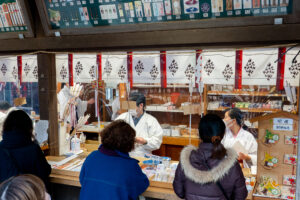 Shrine office
Shrine office 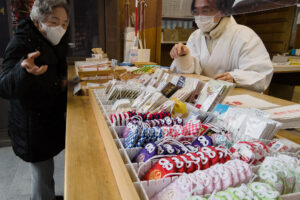 OMAMORI
OMAMORI
HAMAYA
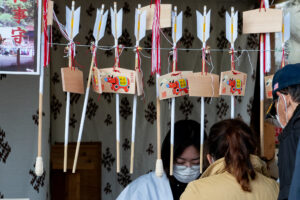
The word of HAMAYA is composed of three characters; HA refers to “destroy or drive away”; MA to “evils”; YA to “arrow”. As this explains, HAMAYA is an arrow to conquer evils and it is a Shinto shrine which offers HAMAYA at the begging of the year (not given by a Buddhist temple). Coming back home, people place HAMAYA at their home alter with its arrowhead downward because putting the arrowhead upwards implies that the arrow is let off heavenwards, which should not happen. As the photo shows (above), the arrowhead is not keen-edged because what HAMAYA is to destroy is not a living creature but JAKI which evils release as malicious vibes to invite misfortune or illness. Even if the arrowhead is not sharp, it exerts a sacred power to drive away JAKI and get the area purified. At the end of the year or at next year’s HATSU-MOHDE, people take HAMAYA back to the shrine, expressing their gratitude for the divine help, and getting a new HAMAYA for the new year. It sounds like a win-win situation being created for both people and a shrine for mutual benefits?
EMA


EMA refers to a picture wooden tablet. E and MA mean “picture” and “horse”, respectively. In the past, those who were in power in the region dedicated a horse or a life-size statue of horse to a Shinto shrine as SHIN-ME (sacred horse), expecting their specific desire or wish to be granted. In later years, such practice of dedication developed into the present style of EMA so that ordinary people were able to express their wishes for divine helps much more easily. People get EMA at a shrine office, write their wishes on its backside, hang it on a fence on the shrine’s precincts, expecting their wishes to be met.

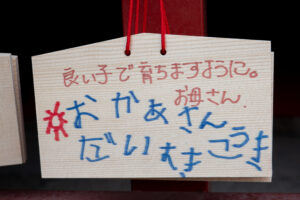
Besides the picture of horse, there are many EMA designs which differ from one shrine to another. TSURUGAOKA HACHIMANGU Shrine which I visited on January 6 provides EMA of this year’s ETO in addition to the universal horse design. ETO refers to the zodiac of twelve animals which are used to express year, month, day, time and direction. ETO of 2021 is cow (above, left). An EMA which I came across (above, right) says, “I wish my son make a good boy (by mom)” and “I love Mom (by KOKI, the son’s name)”. Very heartwarming messages by the mother and her son! I felt very happy from the very beginning of the year. Wish you start a very happy and healthy year, too!
By Jin Shibata
Email: jin.shibata@i3ws.co.jp

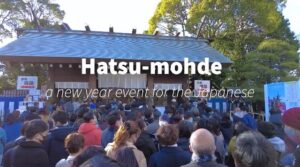
Comment